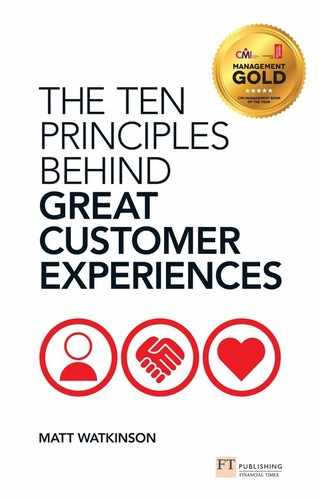Introduction
What this book is about
This book presents ten simple principles that you can use to make improvements to any customer experience. Whether you provide a product or service, are a large or small operation, a physical shop or web-based, it doesn’t matter, these principles are universal.
This is a doing book – the emphasis is very much on practical things that you could do today, to make a real difference to the lives of your customers. To put these principles to work requires no previous expertise or experience, there is no jargon or filler, and where complex concepts arise they are presented in a manner that is accessible and simple to understand. It is my hope that small business owners, would-be entrepreneurs who dream of starting their own business, design professionals, managers and leaders will find it useful.
The advice is based on years of practical experience working with organisations from small local businesses and start-ups through to multi-national, multi-billion-pound turnover companies, in sectors as diverse as advertising, health, transport, travel, finance and telecoms. That said, I will ask you to take little on trust: the key points are all underpinned by rigorous theory from fields as wide ranging as psychology, philosophy, design and business management.
What is the ‘customer experience’?
There is no one agreed definition of what is meant by the term ‘customer experience’ so before we go any further, here is my personal attempt at providing a useful definition:
The customer experience is the qualitative aspect of any interaction that an individual has with a business, its products or services, at any point in time.
I’d like to break this definition down a bit and explain how I came to phrase it this way.
I use the term qualitative to reflect the fact that an experience is perceived by an individual’s sensory and psychological faculties: it is not something that can be measured quantitatively like profit, cost, weight or task completion times. To put it another way, the experience isn’t about what something does, it’s how it does it. It’s not what the features and functions of the product or service allow us to do, it’s how it makes us feel.
Rather than ‘customer’, I prefer to use the term individual in my definition. Many of the most important interactions with a business take place before you actually become a customer – like looking around a shop, waiting to be served or seeing an advert. This is why many web or software designers use the term user experience to reflect that the person interacting with the product or service may not actually be a customer as such. I use individual instead of user since the scope of the book extends beyond websites and software to include any product or service.
It is important to clarify that the customer experience is not restricted to the usage of a product or service: it spans every interaction that a customer has with a business or its offerings. This can be anything from seeing an advert through to cancelling a contract, or disposing of a product when it is no longer of use. As we will see, there are many interactions that are commonly neglected but offer great opportunities to stand out from the competition. Furthermore, since the experience involves every interaction, it cannot be restricted to any period in time, or any defined point in the relationship that the business has with the individual concerned: they may be a prospective customer, a new customer, a loyal customer who offers repeat business; they may even be a customer who has left to take their business elsewhere or no longer has a requirement for our product or service.
What we actually buy is the experience, not just the product or service. The customer experience is all encompassing, and emerges from the work of many distinct disciplines: marketing, branding, product design, service design, interaction or user-experience design (as those in the digital realm often refer to it), and customer services to name a few. It also goes right to the core of the business: operations, strategy and finance all play a role in dictating the customer experience. Over the course of this book we will explore how many of these different disciplines and departments impact on the customer experience.
A skimmer’s guide
The book has been written to be short and easily digestible. My aim was to write it in such a way that the reader could easily read a chapter a day on a half-hour commute, or read the book in its entirety on a transatlantic flight. That said, if you are in a real rush each chapter starts with a paragraph explaining its contents so you can decide upfront whether it’s of interest; each chapter also ends with a summary of the key points that are made.
The first two chapters set the scene by explaining why the customer experience matters so much in business today, and why many businesses are struggling to make improvements; then the principles themselves are introduced in Chapter 3. To an extent each chapter can be read in isolation, but Chapters 4, 5 and 6 form a structure that the rest of the principles hang from – Chapter 4 is about understanding the customer themselves, Chapter 5 helps to pin-point their objectives, and Chapter 6 helps you to structure the customer’s experience in such a way that each interaction can be worked on – so I recommend reading these in sequence, before moving on to the other principles.
